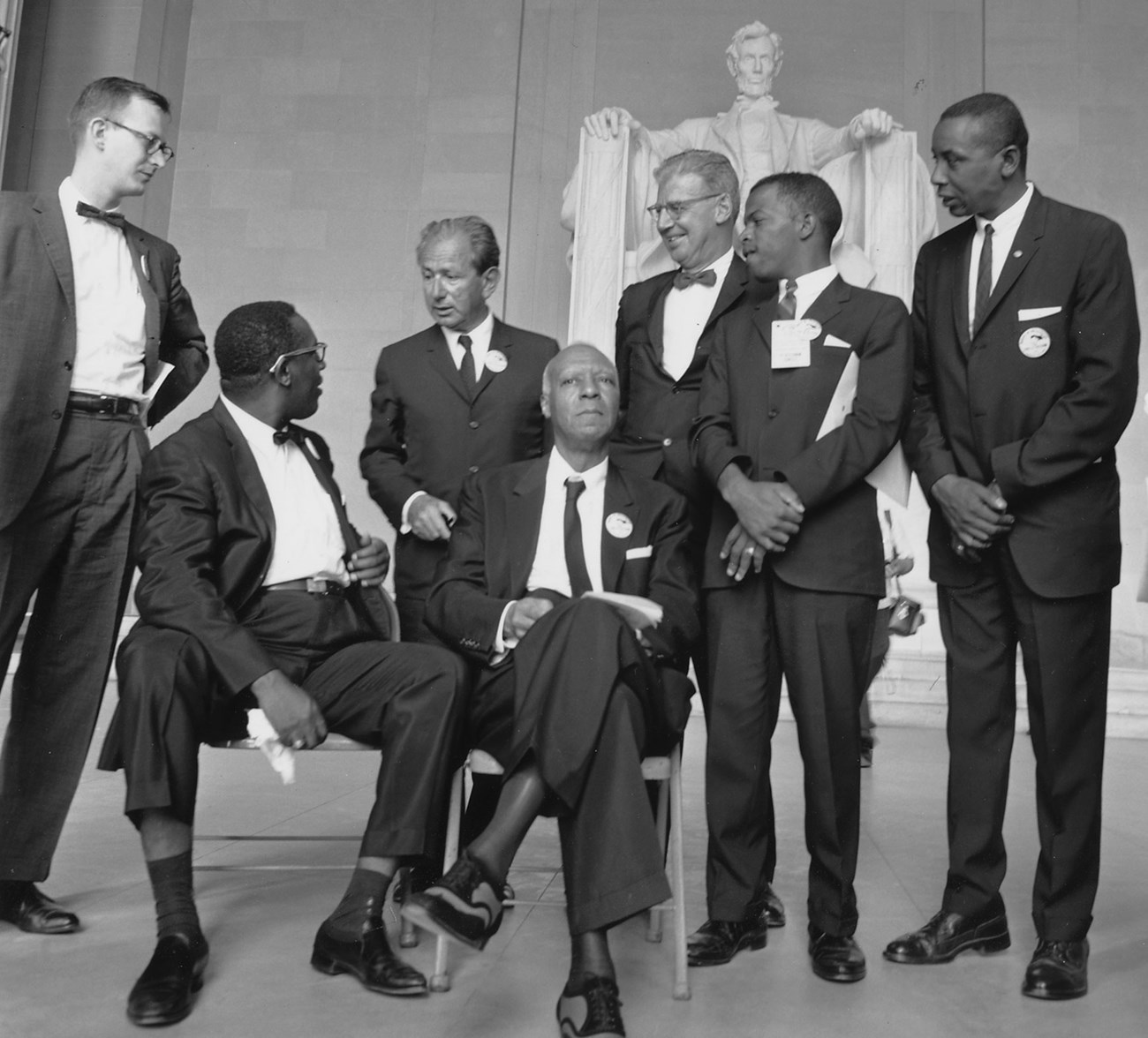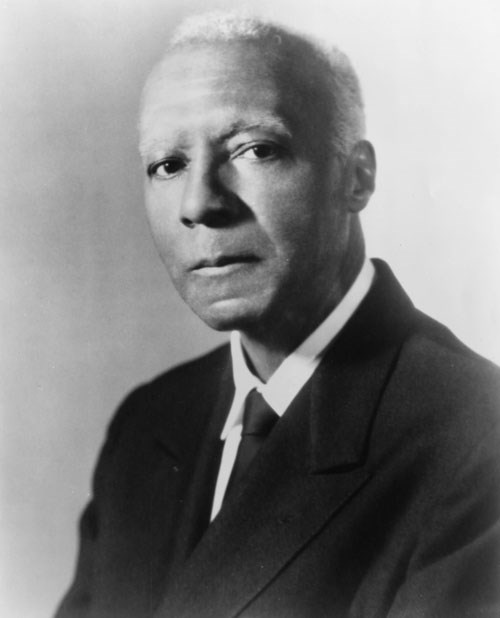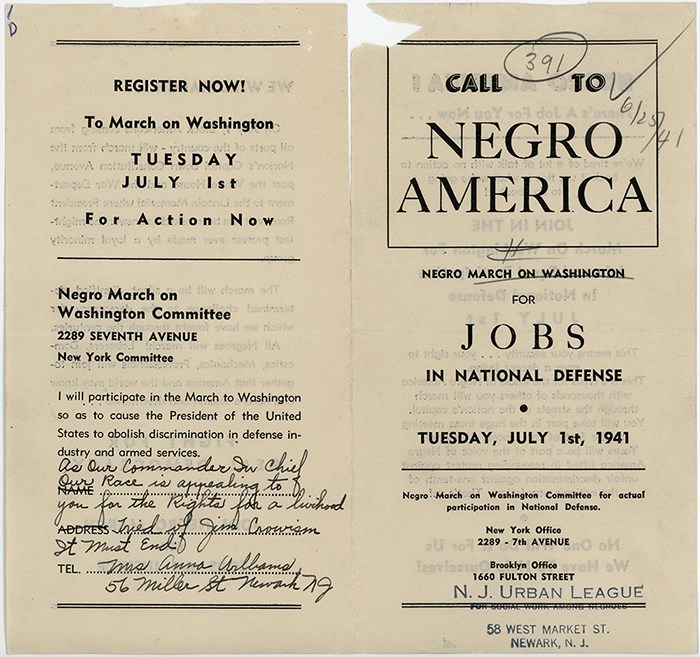
A Philip Randolph (seated, center) with leaders of the 1963 March on Washington: (from right to left) Mathew Ahmann, Cleveland Robinson, Rabbi Joachim Prinz, Joseph Rauh Jr, John Lewis, and Floyd McKissick. National Archives Photo. "In this period of power politics, nothing counts but pressure, more pressure, and still more pressure, through the tactic and strategy of broad, organized, aggressive mass action behind the vital and important issues of the Negro."

Photo courtesy Souther Labor Archives, Geogia State University Libraries. A. Philip Randolph had risen to political prominence through his work on organized labor and was now president of the nation’s most powerful all-Black labor union, the Brotherhood of Sleeping Car Porters (BSCP). He knew something needed to be done to root out segregation in the armed forces. Black Americans were excluded from the Air Corps, the Signal Corps, the Coast Guard, and the Marines. The Navy, the branch of the service that FDR knew best, had no officers of color. African Americans could serve only as messmen, in menial positions. As the NAACP’s magazine, the Crisis, highlighted with a cover showing an airplane factory marked “For Whites Only,” only 0.2 percent of aircraft industry employees were African American in 1940. Randolph, along with the NAACP’s Walter White, Mary McLeod Bethune, and others in the Black Cabinet, lobbied the Roosevelt White House to change the situation. On September 16, 1940, the very day the Selective Service Act was passed by Congress, Eleanor Roosevelt was a guest of Randolph and addressed the Brotherhood of Sleeping Car Porters’ convention at the Harlem YMCA. Two days later, she called FDR’s press secretary, Stephen Early, to instruct him to arrange an “important and immediate” White House meeting “to discuss the rights of Negroes—their rights to volunteer, their rights under the [Selective Service] Conscription Act, their general rights to participate in the whole structure of national defense, but particularly the Army and Navy.” Under pressure from ER, FDR convened a White House meeting on September 27 with his secretary of the Navy and undersecretary of war, as well as Randolph, White, and T. Arnold Hill of the Urban League. Of the three, Randolph would emerge as the undisputed leader of efforts to integrate the US military and increase African American participation in the broader national defense effort. The meeting was recorded, as Roosevelt was the first president to install audiotape equipment. The recording suggests a disconnect between the three Black leaders and Roosevelt, who touted his proposed military draft as an improvement on World War I. FDR was noncommittal on the specifics of the memorandum they brought to the meeting which demanded the wholesale desegregation of the US armed forces. Randolph insisted that “the Negro people . . . feel they are not wanted in the armed forces of the country, and they feel they have earned the right to participate in every phase of the government by virtue of their records in past wars since the time of the Revolution.” FDR suggested minor adjustments of Jim Crow policy to appease the civil rights leaders. Racial change, in the president’s view, should be limited and gradual: “A little opportunity here, a little opportunity there.” When White handed over petitions from eighty-five veterans’ posts condemning segregation, FDR cut him off, and the meeting ended abruptly. FDR had promised to get back to Randolph and his colleagues about their memorandum, but he never did. His press secretary, Stephen Early, made matters worse by telling reporters that Randolph, White, and Hill had gone along with FDR’s decision to keep the military segregated. When the Black press attacked FDR and the three leaders for accepting the status quo, Randolph, White, and Hill released their memorandum to prove they had demanded integration and greater access to defense industry jobs. They added that FDR’s continued support for a segregated military was “a stab in the back for democracy.” Randolph, White, Bethune, and other members of the Black Cabinet, along with their white allies in the Roosevelt administration, all urged FDR to take some action to give African American voters a reason to stay within his Democratic coalition in the upcoming election. In the final two weeks of the presidential campaign, FDR announced a flurry of appointments of African Americans to prominent military roles. FDR also promised African Americans access to aviation training and greater opportunities to serve as officers in the military. FDR’s last-minute appointments may have helped him win the 1940 election, but they did not satisfy Randolph. These changes, while important symbolically, had sidestepped the issue of desegregating the military, the core reform that Randolph and the other Black leaders had demanded in their White House meeting. On a trip south to meet Brotherhood officials in December 1940, Randolph told his travel companion Milton Webster, “I think we ought to get 10,000 Negroes to march on Washington in protest, march down Pennsylvania Avenue” to demand jobs in defense industries and to integrate the military. 
Franklin D. Roosevelt Presidential Library. The idea of a March on Washington quickly percolated up through the Black press. At a gathering of civil rights groups in Chicago in early January 1941, one African American woman gave a fiery speech on the defense industry’s exclusion of Black workers, announcing, “we ought to throw 50,000 Negroes around the White House, bring them from all over the country, in jalopies, in trains and any way they can get there, and . . . keep them there until we can get some action” from the president. Randolph was not ready to increase the size of the march to fifty thousand, but the idea grew into the formation of a March on Washington Committee with Randolph as director and White and the Urban League’s Lester Granger in prominent roles alongside other labor, educational, religious, and civic leaders. In announcing the march in late January, Randolph issued a stark denunciation of “the whole National Defense set up” that “reeks and stinks with race prejudice.” In March 1941, Randolph declared that “mass power can cause President Roosevelt to issue an executive order abolishing discrimination in defense jobs and the military.” Across the nation, members of the Brotherhood, the NAACP, the Urban League, and other organizations began forming local chapters of what had now become the March on Washington Movement. Randolph also set a date: July 1. By late May, Randolph appeared so confident of the growing support for a march that he vowed that one hundred thousand African Americans would descend on Washington, and he invited leading Washington figures to address the march, including Secretary of War Stimson, Secretary of Labor Frances Perkins, and Franklin and Eleanor Roosevelt themselves. There remained many who doubted that the march would actually take place or that Randolph could muster ten thousand people, let alone ten times that. Even Randolph’s strongest supporters worried about logistics: where would the predominantly Black marchers eat, find lodging, or go to the bathroom in the segregated capital? ER wrote to Randolph to tell him that she had discussed the situation with the president, “and I feel strongly that your group is making a very grave mistake.” FDR agreed. He called in Aubrey Williams, a liberal white southerner who headed the National Youth Administration and ordered him to resolve the matter. “Go to New York and try to talk Randolph and White out of this march. Get the missus [Eleanor] and Fiorello [La Guardia] and Anna [Rosenberg] and get it stopped.” At a meeting on June 13, 1941, ER made clear that she shared the movement’s desire to increase opportunities for Black defense work but feared that a mass demonstration of African Americans in the nation’s capital could lead to violence at the hands of the overwhelmingly white, southern police force. ER told the president that only a direct meeting between himself, his secretaries of war and the Navy, La Guardia, Randolph, and White could prevent the March on Washington Movement from acting on its threat. When they convened at the White House, Randolph and White offered to call off the march once the president issued an executive order barring discrimination in defense jobs and the military. Eager to settle the matter, the president tasked Joseph Rauh, one of the brightest young lawyers in Roosevelt’s administration, with drafting a fair employment practices order. Rauh’s recollection was that Roosevelt was more concerned with “social stability, rather than concern for black workers,” but that his fear of a destabilizing march required an urgent solution. On June 25, 1941, after days of tough negotiation—and six days before the scheduled march—all parties agreed on a formula. The president promised to issue an executive order prohibiting racial discrimination in defense work and establishing a Fair Employment Practices Committee to enforce it. FDR’s order represented a major victory for Randolph’s campaign. ER’s relief was palpable: “My dear Mr. Randolph: Thank you for your wire. I am very glad the march has been postponed and delighted the President is issuing an executive order on defense industries. I hope from this first step, we may go on to others.” The Chicago Defender hailed Randolph for ushering in the “death of Uncle Tom-ism” while the New York Amsterdam News called Executive Order 8802 “epochal.” An editorial in that paper even suggested that “Randolph, courageous champion of the rights of his people,” had taken “the helm as the nation’s No. 1 Negro,” and “is being ranked along with the great Frederick Douglass.” Bayard Rustin, a part-time City College student and the director of the March on Washington Movement’s Youth Division, urged Randolph, nevertheless, to continue with the march until all of its goals—including desegregation of the military—were met. Despite this early difference on tactics, Randolph would become an important mentor to Rustin, encouraging him to abandon communism in favor of socialism and pacifism as practiced by Mohandas K. Gandhi. In 1963, they would team up to plan—and carry out—the historic March on Washington. From the perspective of Randolph, other civil rights leaders, and millions of Black workers, the Fair Employment Practices Committee did not go nearly far enough. It was chronically underfunded and understaffed, and many businesses, notably the railroad industry that Randolph knew so well, ignored the committee’s extensive findings of discrimination against qualified African American workers. Another weakness of the Committee was that it was a temporary wartime measure. As one March on Washington Movement poster put it: “And brother, if you’ve had it tough, wait until after the war!” Once “the shooting ends,” Randolph warned, Black workers would once more be “last hired and first fired.” While several northern and western states established Fair Employment Practices Commissions in the 1940s and 1950s, it would take another thirteen years, with the passage of the 1964 Civil Rights Act and the establishment of the Equal Employment Opportunity Commission, for Randolph’s dream of a permanent Fair Employment Practices Committee to be realized at the national level. More than two decades after Randolph’s initial proposal, the March on Washington for Jobs and Freedom on August 28, 1963—a broadly peaceful gathering of a quarter of a million people primarily remembered for Martin Luther King, Jr.’s stirring “I Have a Dream” speech—was the continuation and culmination of the tireless civil rights leader’s wartime efforts. _______________________
Explore the original report, The Roosevelts & African American Civil Rights Leaders, which features in-depth stories and additional leaders. DOWNLOAD THE REPORT |
Last updated: January 15, 2024
